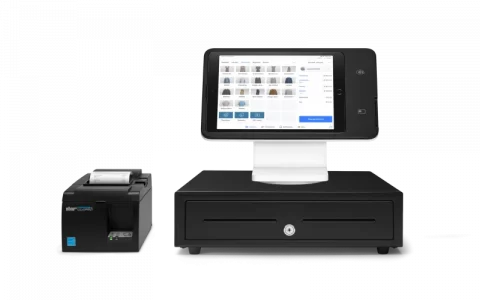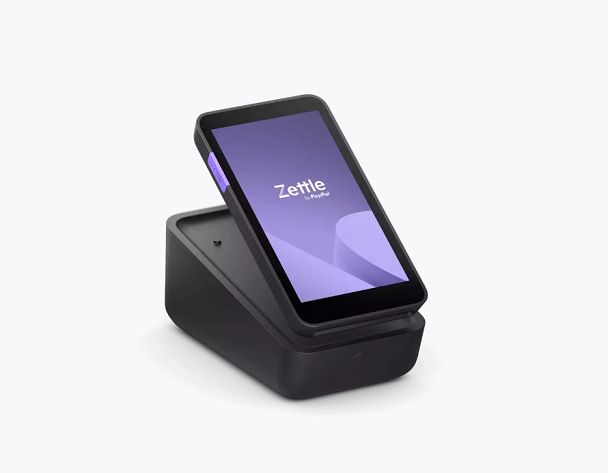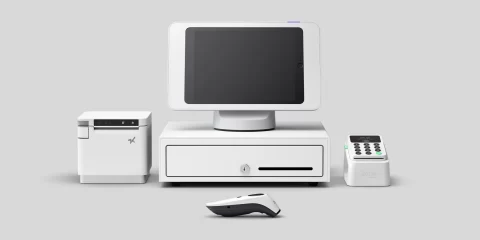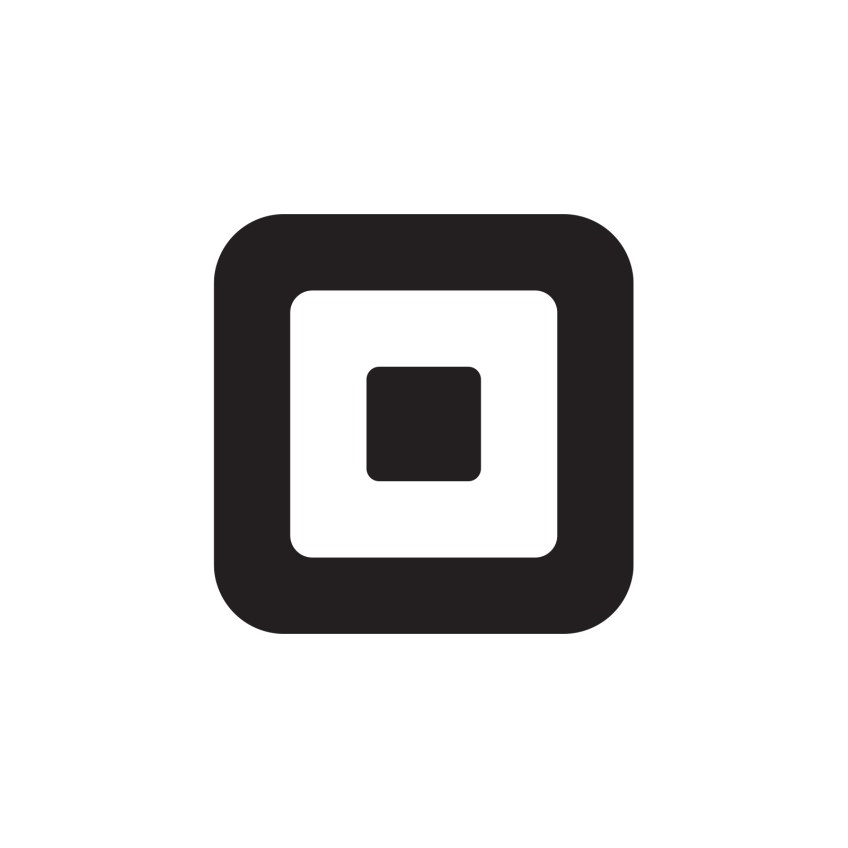
Choosing the right POS till system can differentiate between a streamlined checkout experience and a logistical nightmare. As businesses adapt to an increasingly cashless society, having an efficient and reliable card payment solution is not just an option—it’s critical.
With over a decade spent analysing POS systems, our expertise will guide you through two significant players: Zettle and Square.
Zettle—formerly known as iZettle—and Square are giants in the world of payment processing, each offering unique tools designed to simplify transactions and enrich business operations.
In today’s market, where 66% of all point-of-sale transactions are expected to be contactless by 2024, knowing which system best aligns with your business needs could set you up for success—or leave you scrambling to catch up.
Key Takeaways
- Zettle and Square are great for cashless payments but have different pricing and hardware options.
- Zettle is simple to use and suitable for small businesses, whilst Square has more enterprise management features.
- They both protect your customer’s card details with high security.
Overview of Zettle and Square

In analyzing Zettle vs Square, both card readers stand out as leading payment processors in terms of pounds in the UK. Each provides various services tailored for the modern merchant. Zettle, once known as iZettle before being acquired by PayPal, offers a dynamic card reader that integrates seamlessly with mobile devices and POS software, making it a strong contender in the world of cashless transactions.
It’s designed to accommodate businesses of all sizes, facilitating payments via credit cards, Apple Pay, Google Pay, and other contactless methods directly through an iPad or Android device.
On the flip side, Square has established itself as a heavy-hitter in point-of-sale solutions since its inception. Its comprehensive ecosystem supports everything from chip-and-pin transactions to online sales through a single platform.
With its range of hardware, including sleek card readers that work with tablets, smartphones, and advanced POS terminals, Square answers the call for versatility whether you’re managing an online store on Shopify or running a bustling marketplace stall.
Both platforms strive to simplify financial operations by offering tools like stock management features and detailed invoicing – paving the way for effortless synchronisation with accounting giants like QuickBooks.
Comparing Zettle and Square

Zettle and Square offer a range of pricing and features for business management, with differences in hardware options, setup processes, and security measures.
Pricing and fees
Understanding the cost implications of your payment processing solution is critical for your business’s bottom line. In this comparison of Zettle and Square, we’ll break down their pricing structures and fees to help you make an informed decision.
| Zettle | Square | |
|---|---|---|
| Initial Cost | Free for the basic card reader | Free introductory reader, with additional cost for more advanced options |
| Transaction Fees | 1.75% per card transaction | 1.75% for chip and PIN & contactless payments |
| Monthly Fees | None | None |
| Invoice Fees | 2.5% per invoice transaction | 2.5% for invoices paid online |
| Additional Hardware | Various options at different costs. An additional card reader will cost £59 | Range of hardware available with differing prices |
Chargeback Fees | No chargeback fees | Dispute management with potential fees |
| International Cards | Additional fees may apply | Additional 1.5% fee for international cards |
| Offline Transactions | Not supported | Offline mode available with standard transaction fees |
Selecting the right payment platform hinges on how these costs align with your business’s operational needs and financial strategy. The Zettle terminal costs £149 for an all-in-one combined POS system. Zettle and Square offer competitive and transparent pricing, but the nuances could sway your decision. Assess each fee category carefully and consider how it impacts your business model. This will ensure that you are getting value for your pounds.
Features for business management
As we move from discussing costs, let’s look at what Zettle and Square offer to help you run your business. Both provide a range of tools designed to make life easier for shop owners and online merchants.
Zettle steps up with an impressive point-of-sale software that simplifies sales, whether it’s for a coffee shop or a mobile hairdresser. It accepts card payments, including Visa and Mastercard, and mobile wallets like Samsung Pay.
Plus, the system makes it easy to track all transactions in real-time.
Square is also big on features that support business management. It has options for managing inventory, tracking staff hours, and setting up customer loyalty programs. Square can handle online payments through e-commerce platforms and lets businesses sell products directly from social media pages.
Creating QR codes for quick checkouts is another handy feature they offer.
Both systems are set up to print receipts swiftly and support contactless cards, ensuring customers have a smooth checkout experience. They aim to keep you ahead by integrating with apps like QuickBooks or Xero so your accounts stay up to date effortlessly.
Ease of use
Zettle and Square make taking payments easy. Both work well with iOS and Android devices, so you can use your phone or tablet to get paid. You just download their app, connect a card reader via Bluetooth, and start accepting cards like Visa, Mastercard, American Express, and Discover.
Zettle is excellent for its simple interface, which means less time spent learning how to use the system.
The square stands out with features that help if you sell online or have an inventory to manage. It lets you track sales in real time and has tools for handling items by barcode – which helps you stay organised.
The apps from both Zettle and Square are free to get started with; they also support things like printing receipts through Bluetooth printers or ringing up sales on cash drawers if needed.
Hardware

Moving from how easy these systems are to use, let’s talk about the machines and gadgets they offer. Zettle gives you a small card reader that works with an app on your iPhone or Android phone.
This device lets you take payments from cards like Visa, Mastercard, and even those tap-to-pay phones or watches.
Square also has a pocket-sized reader for credit and debit cards and can read barcodes. Their hardware range goes further with a stand for iPads and more extensive registers that print bills.
Zettle is fantastic if you want something simple, while Square is great when you need more tools to help run your shop or café. Both ensure customers can pay their way, whether with chip cards, contactless phones or classic magnetic stripes.
Set up
After choosing the proper hardware, setting up your payment system is the next step. Zettle makes this process relatively simple. You just need to create an account, connect your bank details, and be ready.
Their app helps guide you through each step, so it’s hard to get lost. Plus, they have a handy FAQ section that can answer your questions.
Square also aims for a smooth start-up experience. Sign up online, download their app and plug in their reader – it’s relatively straightforward. You’ll find guides and videos on how to set everything up, making it easy even if technology isn’t your strong suit.
They support various card types like Visa Electron and Maestro, ensuring you can accept payments from a wide range of customers without trouble. Both systems are designed with security in mind; they meet PCI DSS standards, keeping customer data safe during transactions.
Security
Security is critical when you’re taking payments. Zettle and Square both take this very seriously. They follow PCI compliance to protect card details. This means they meet high safety standards, ensuring customer information stays secure during every sale.
They also help with chargeback protection, guarding your business if a customer says they didn’t buy something from you. Your sales are safe using mobile payments, online transactions or payment terminals.
Related: Restaurant POS System & Security
Similarities and Differences between Zettle and Square
As we explore the landscape of mobile payment solutions, Zettle and Square often emerge as prominent choices. Each offers a suite of features designed to cater to the needs of modern businesses, yet their approaches exhibit distinct characteristics. Let’s delve into a comparative analysis, highlighting the similarities and differences that shape the user experience for each platform.
| Criteria | Zettle | Square |
|---|---|---|
Pricing Structure | Transparent pricing with no monthly fees; charges per transaction | Free introductory reader, with additional cost for more advanced options |
Hardware Options | Offers a range of card readers and POS hardware; integration with existing equipment is possible | 1.75% for chip and PIN & contactless payments |
Feature Set | Strong focus on payment processing with additional business tools | None |
| Invoice Fees | User-friendly with a focus on simplicity and ease of navigation | 2.5% for invoices paid online |
User Interface | Quick setup, designed to get merchants up and running swiftly | Range of hardware available with differing prices |
Setup Process | No chargeback fees | Streamlined setup, though additional features may require more time to configure |
Security Measures | Complies with industry standards; offers encryption and protection against fraud | Meets high-security benchmarks with advanced fraud prevention and data encryption |
Both platforms share a commitment to delivering secure, user-friendly payment processing solutions. They diverge in their pricing models, hardware offerings, and the breadth of their business management features. This analysis serves to illuminate the unique attributes of each, empowering you to make an informed decision tailored to your specific business goals.
Conclusion
In conclusion, understanding the differences and similarities between Zettle and Square is crucial for making informed business decisions. Efficiency in managing fees and prices in pounds, features, ease of use, hardware compatibility, setup process, and security are vital considerations when choosing a payment processing system.
Implementing the right platform can significantly improve business operations and customer satisfaction. Remember to explore further resources or services available if you seek additional guidance.
With the right choice between Zettle vs Square, your business can thrive in today’s competitive market.
FAQs
What is the difference between Zettle and Square?
Zettle and Square are tools that help with payments in shops, online stores, and other places where people buy things. They let you take card payments from major networks like Visa or UnionPay.
Can I use Zettle for my online store?
Yes, you can use Zettle for your online store. It helps you smoothly sell things across different channels so customers have a great experience.
Does Square support prepaid cards as payment?
Square accepts prepaid cards and others like Diners Club cards to ensure many customers can pay however they want.
Will I face chargebacks using either Zettle or Square?
With both Zettle and Square, there is a risk of chargebacks when customers say they didn’t agree to a payment or didn’t get what they purchased.
Can businesses get cash advances with these services?
Both services offer ways for merchants to get cash in advance based on how much money their business makes through their merchant accounts.
Best POS software











